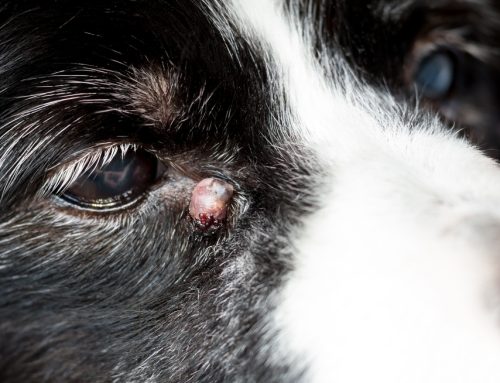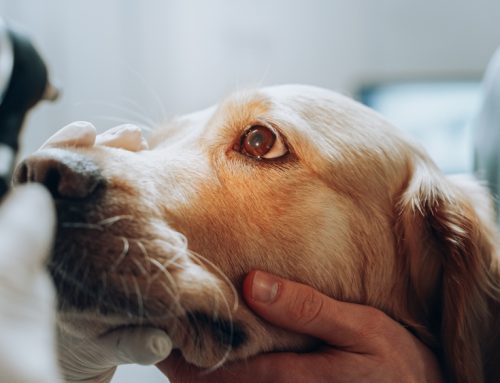Every May, the American College of Veterinary Ophthalmologists (ACVO) participates in the National Service Animal Eye Exam Event. Throughout the month, registered service and working animals can receive free eye exams at participating providers, including Veterinary Vision Center. The event was canceled the past two years because of the COVID-19 pandemic, but this year we’re excited to once again offer this service to the dedicated and deserving working dogs of our community.
Service and working dogs can do many amazing things—the scope of their talents and abilities far outreaches those that humans can do on their own. While much of what dogs do for humans is based on scent work, their job also relies heavily on their clear, reliable vision. A working dog with impaired vision may endanger their owner, so screening working dogs yearly for eye health changes allows for vision assessment to ensure they are fit for their job. If problems are noted, treatment can begin right away to keep them visual and working as long as possible.
How service dogs rely on vision
A dog can be trained to do almost anything physically possible, and we have certainly harnessed that power. Many types of service and working dogs exist and, with the exception of scent detection and therapy dogs, most must use vision in some way to complete their job. Here are some ways various service and working dogs use vision in their daily tasks:
- Guide dogs for the blind — Dogs who guide blind humans absolutely must possess good vision, as they act as their person’s eyes to keep them safe from obstacles, traffic, and general dangers.
- Mobility assistance dogs — These dogs assist people with mobility impairments, or in wheelchairs. They need vision to navigate unfamiliar spaces, identify objects to retrieve, find light switches and door handles, and more.
- Medical assistance dogs — Seizure assistance dogs need to see where their person has fallen, physically move them into a safe position, retrieve emergency medications, and seek help. Other medical conditions require similar assistance.
- Psychiatric disability assistance dogs — Those with PTSD, severe anxiety or depression, or other mental health issues benefit from dogs who are able to closely observe their person’s body language and behavior. The dog will often disrupt repetitive or dangerous behaviors, or block others from approaching too closely in a crowd.
- Police dogs — Much police work involves tracking and scent, but for patrol and apprehension, the dog must have good vision to chase, navigate, and apprehend a suspect on the run.
- Military dogs — Some military dogs are trained solely as border patrol, sentries, and scouts, and their sole job is detecting intruders using scent and vision, especially night vision. Others are trained to find casualties, which requires excellent navigation skills.
- Search and rescue dogs — While using dogs for search and rescue involves their excellent sense of smell, they also must have good vision to navigate treacherous terrain after natural or man-made disasters.
Common eye diseases affecting working dog breeds

Some vision changes occur with normal aging, while others can occur at any age. Some eye diseases have effective treatments, and others may cause vision loss that cannot be reversed or prevented. Whatever the case, early disease detection is best for working dogs, and handlers should watch for problems, or retire the dog. Some eye problems commonly encountered in working dog breeds include:
- Nuclear sclerosis — This normal change starts after age 7, and results in slight lens clouding and depth perception difficulty. Most dogs adjust well and have no noticeable vision changes, but some high-performance dogs may start to have depth problems.
- Cataracts — Cataracts are a hardening and white lens clouding that can occur at any age, though typically in older or diabetic dogs. Cataracts can progress slowly or quickly, and may eventually lead to blindness. Vision can be restored with surgical cataract removal.
- Primary glaucoma — Glaucoma causes high pressure inside the eye, typically beginning in one eye, progressing to both eyes, and eventually leading to blindness. Eye drops can lower eye pressure, but they will eventually stop working. If vision preservation is important, as is the case for most working dogs, surgery can prevent vision loss, but cannot restore any lost vision.
- Corneal disease — Pannus, a type of corneal inflammation, is commonly seen among working dog breeds, like German shepherds, and can be treated with lifelong medications to reduce inflammation and corneal pigment, and to keep vision clear.
- Retinal disease — Progressive retinal atrophy (PRA) commonly occurs in Labrador retrievers, but can affect any breed. This painless condition leads to slow, progressive vision loss, beginning with night blindness, and progressing to day blindness. Early disease detection can help handlers understand what to expect, and retire their dog if their duties require good vision. This retinal disease cannot be treated.
Here at Veterinary Vision Center, many of our pet patients live happy, healthy, quality lives, despite blindness or vision impairments. However, for working dogs, vision is an important part of their job, and we want to ensure we keep them seeing and working as long as possible. If your service dog needs a free screening eye exam, registration is open through April 30. You can register here and call us to schedule an appointment during the month of May.







Leave A Comment